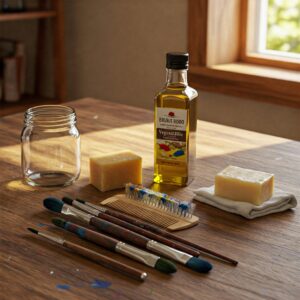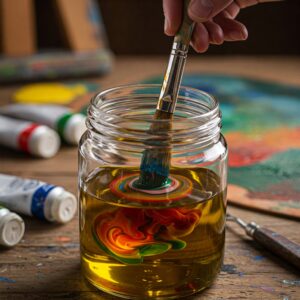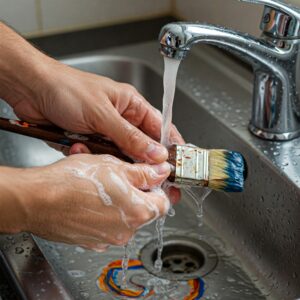Oil painting is a rewarding artistic pursuit, but cleaning brushes afterward often involves harsh chemicals that can harm both your health and the environment. Fortunately, there are numerous natural, eco-friendly alternatives that clean your brushes effectively while preserving their quality. This comprehensive guide explores how to clean oil paint brushes naturally using common household items, helping you maintain your artistic tools sustainably.
Key Points:
- Natural oils like vegetable or olive oil effectively break down oil paint
- Gentle soaps and mild dish detergents provide thorough cleaning without damage
- Regular maintenance extends brush life and preserves bristle quality
- Eco-friendly cleaning methods reduce environmental impact
- Natural alternatives are safer for health and typically less expensive
Why Clean Your Brushes Naturally?

Traditional oil paint brush cleaners contain harmful chemicals like turpentine and mineral spirits that release volatile organic compounds (VOCs) into the air. These toxins can cause respiratory issues, headaches, and skin irritation with prolonged exposure. Additionally, improper disposal of these solvents contributes to environmental pollution.
By switching to natural cleaning methods, you:
- Eliminate exposure to toxic fumes
- Reduce your environmental footprint
- Save money on expensive art solvents
- Often achieve equally effective cleaning results
- Extend the life of your brushes
Artist and environmentalist Sarah Green notes, “Making the switch to natural brush cleaning methods not only improved my studio air quality but also gave me peace of mind knowing I’m practicing my art more sustainably.”
Essential Natural Supplies for Cleaning Oil Paint Brushes
Before starting your eco-friendly brush cleaning journey, gather these supplies:
| Supply | Purpose | Notes |
|---|---|---|
| Vegetable oil | Paint breakdown | Canola, sunflower, or olive oil all work |
| Mild soap | Final cleaning | Baby soap, castile soap, or mild dish soap |
| Glass jars | Cleaning containers | Repurposed food jars work perfectly |
| Paper towels or rags | Wiping excess paint | Reusable cloths are more sustainable |
| Brush comb/tool | Bristle separation | Wooden or plastic options available |
| Conditioning soap | Bristle care | Optional but recommended |
Step-by-Step Natural Cleaning Process
1. Remove Excess Paint
Begin by removing as much paint as possible from your brushes before any wet cleaning:
- Gently wipe brushes on scrap paper or cloth
- Use the edge of a palette knife to scrape excess paint
- Blot (don’t rub) with an absorbent rag
- Separate bristles to release paint trapped inside
2. The Vegetable Oil Method

Vegetable oil is remarkably effective at breaking down oil paint because like dissolves like:
- Pour about 2-3 tablespoons of vegetable oil into a small glass jar
- Dip your brush and swirl gently against the bottom or sides
- Work the oil through the bristles with your fingers, moving from ferrule to tip
- Wipe excess oil and dissolved paint onto a paper towel or rag
- Repeat if necessary until most of the paint is removed
For stubborn paint, let the brush soak in oil for 30-60 minutes, but avoid soaking wooden handles as this can cause swelling and cracking.
“I was amazed at how well simple kitchen oil worked on my brushes. Even dried paint that I thought had ruined my favorite brush came out with a little patience and vegetable oil.” – Marcus Reid, Landscape Oil Painter
3. Soap Cleaning and Conditioning

After the oil treatment, you’ll need to thoroughly remove the oil with soap:
- Apply mild soap or detergent directly to the brush bristles
- Gently work the soap into a lather on your palm or a textured surface
- Rinse under lukewarm (never hot) water
- Repeat until the water runs clear and no oil residue remains
- If available, use a conditioning brush soap as a final step
For particularly stubborn paint, you might need to use a brush comb to carefully separate the bristles while the soap is still in them.
4. Drying and Reshaping

Proper drying is critical for maintaining brush shape and extending bristle life:
- Gently reshape the bristles with your fingers
- Remove excess water by lightly blotting (not rubbing) with a clean cloth
- Lay flat on a towel for a few minutes to drain additional moisture
- Stand brushes upright with bristles pointing upward to dry completely
- Never rest brushes on their bristles while drying
Avoid using a hairdryer or placing brushes near direct heat sources, as this can damage the bristles and handles.
Natural Solutions for Challenging Situations
Dealing with Dried Paint
Dried oil paint presents a special challenge but isn’t impossible to remove naturally:
- Soak the brush in warm vegetable oil for several hours or overnight
- Gently work the oil into the bristles periodically
- Use a brush comb to carefully separate bristles
- Follow with the regular soap cleaning method
- Repeat if necessary
For extremely hardened paint, you might need to try a paste made from equal parts baking soda and vegetable oil, working it gently into the bristles before rinsing.
Natural Deep Cleaning for Neglected Brushes

For brushes that need rehabilitation:
- Heat (don’t boil) some vinegar in a non-aluminum pan
- Soak brush bristles (not the handle) for up to 30 minutes
- Remove and immediately work vegetable oil into the bristles
- Clean with soap as described above
- Condition thoroughly afterward
This method should only be used occasionally as a rescue technique for severely neglected brushes.
Additional Natural Alternatives Worth Trying
Beyond the basic vegetable oil method, several other natural alternatives can effectively clean oil paint brushes:
Baby Oil Method
Baby oil works similarly to vegetable oil but tends to be more refined:
- Apply baby oil directly to the brush bristles
- Work into a lather between your fingers
- Wipe on a rag and repeat until clean
- Wash thoroughly with soap afterward
Linseed Oil Option
Artists who already use linseed oil in their painting can repurpose it for cleaning:
- Dip brush in linseed oil and work through bristles
- Wipe excess on rag or paper towel
- Repeat until most paint is removed
- Follow with soap washing
Remember that linseed oil-soaked rags must be disposed of properly as they can spontaneously combust.
Citrus-Based Solutions
For a pleasant-smelling natural option:
- Mix 1 part citrus essential oil (like lemon or orange) with 2 parts vegetable oil
- Use this mixture as you would plain vegetable oil
- The citrus adds extra cleaning power and a fresh scent
Preventative Care and Maintenance
The best cleaning strategy is regular maintenance:
- Clean brushes immediately after each painting session
- Never let paint dry on your brushes
- Store brushes properly: either lying flat or standing with bristles up
- Apply a small amount of brush conditioner monthly
- Rotate your brushes during long painting sessions
Environmental Considerations and Disposal
Proper disposal of your natural cleaning materials is important:
- Let oil-soaked paper towels dry completely before discarding
- Collect used cleaning oil in a sealed container for proper disposal
- Never pour oil down the drain
- Consider setting up a jar with a lid for temporary brush cleaning between colors
Many communities have hazardous waste collection where you can dispose of used oils properly.
Final Thoughts on Natural Brush Cleaning
Switching to natural methods for cleaning your oil paint brushes not only benefits your health and the environment but can also extend the life of your artistic tools. The methods described here are effective for both beginner oil painters and experienced artists.
According to a recent survey by Sustainable Art Supplies, 78% of artists who switched to natural cleaning methods reported no difference in cleaning effectiveness, while 65% noted improvements in brush longevity.
By incorporating these eco-friendly techniques into your studio organization and maintenance routine, you’re making a small but significant contribution to more sustainable artistic practices.
Remember that patience is key—natural methods may take slightly longer than chemical solvents, but the benefits to your health, your brushes, and the planet make it well worth the extra few minutes.
For more information on sustainable art practices, check out this comprehensive guide on sustainable art-making.
What natural cleaning methods have you tried for your oil paint brushes? Share your experiences and tips in the comments below!



